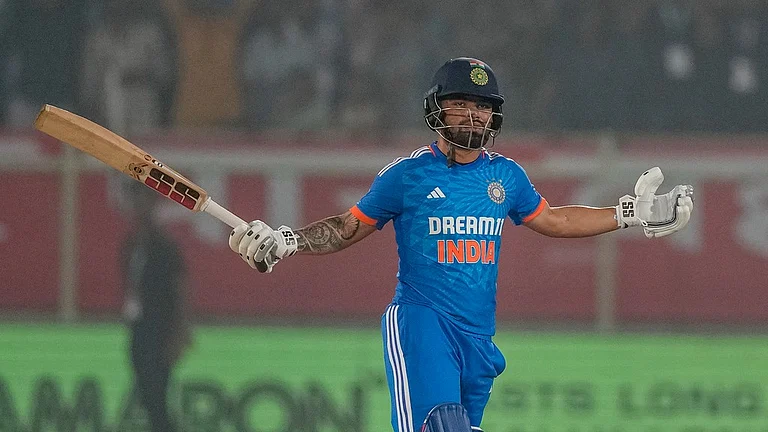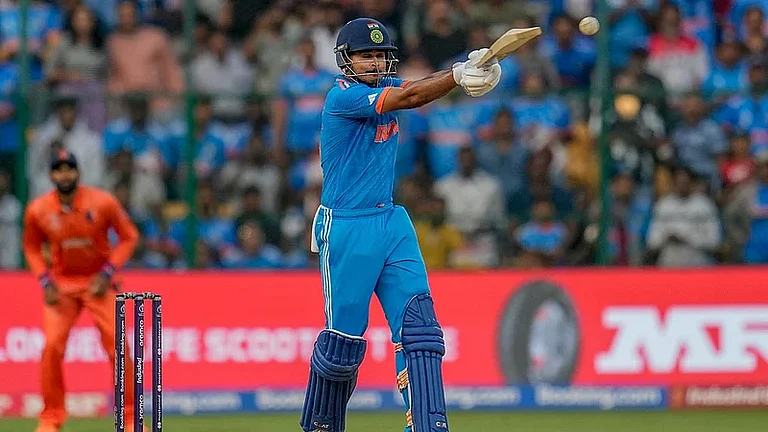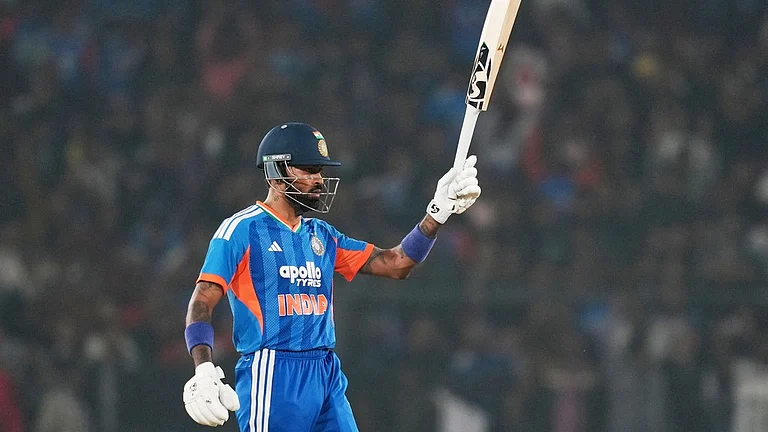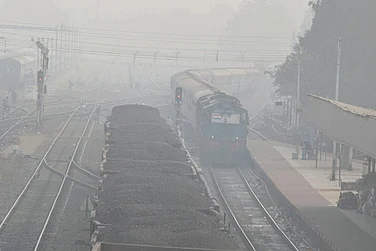In an interview with Mary E John, former director of Centre for Women's Development Studies, New Delhi, Outlook’s Omar Rashid discussed the wave of action against child marriages by the Himanta Biswa Sarma-led BJP government in Assam.
Q. The way the Assam government has gone about arresting hundreds of people for child marriage cases, some have argued it can serve as a deterrent. Do you feel so? You have, in fact, argued that it is counter-productive.
A. Is something like a deterrent called for or justified? There should be a match between the problem and the action. When we say deterrent, we say high sentencing, for instance, in rape cases. It's supposed to be a deterrent. It's supposed to scare off would-be rapists. Whereas if you have a light sentence, it is supposed to enable. If that is the meaning of deterrent, it's not being used correctly in this context. This is not a crime in the sense that rape might be. While it's also true that Assam has higher rates than average, these rates have been coming down. Some places quite dramatically so.
Second, it's not as if the issues that are being claimed will be sorted or solved by raising the age of marriage. Many factors that affect women's health and well-being are not solved. In situations of these sorts, where women are up against multiple disadvantages due to poverty, their lack of nutrition, poor quality of health services, or quality of schooling; whatever it may be, the age of their marriage is not the single most important factor that actually affects their lives. Something like anaemia, which is a very significant factor in high bleeding at the time of childbirth, is one of the reasons we have high rates of maternal mortality. If nothing has changed in her life and if you only delay her marriage, her anaemia doesn't get any better. Her chances of maternal mortality rates are not at their highest under 18 when you have control over other factors. When you don’t control for other factors…what everybody gets misled by is that the higher age of marriage goes hand-in-hand with better-off families. Better-off families marry off their daughters at a higher age. Poorer families marry at lower ages. People get the cause and effect confused. So, when you are poorer you get married sooner and it is not the other way around.
Q. Poverty causes early marriage, you are saying?
A. Yes, I'm saying so and it's the truth. Yes, upper caste and well-regarded Indians in the 19th and early 20-century were marrying off their girls as children. This was a fact. We know that even famous people like Mahatma Gandhi married very young. And it was a massive issue of social concern in this emerging Hindu middle class. It was an issue for them…it was very widespread. It was like standard practice, so you didn't have a notion of a child in those days. That has changed over the centuries. The age of marrying has been going up, thanks to a lot of effort on the part of reformers but also thanks to modernization, which changes the equation. Once education becomes part of growing up for men as well, men have to go through so many years of education to get a job. They want partners who are also similarly educated. The whole equation changes.
For the very poor who don't have access to all these possibilities and for whom after elementary schooling, there is nothing much else in life. For them, the fear of what would happen if you waited too long and that you might be exposed to the vulnerability, you might face of a young daughter growing up, might actually propel you to an earlier marriage. Mind you these early marriages are not of children; these are what I would call teenagers or adolescents. Early marriage is of the age group 15-17. That 31.8% figure (child marriage rate) for Assam, out of that only 8 per cent are 14 and below of age. A very small proportion.
Q. So these are ‘teenage marriages’ and not ‘child marriages’ happening?
A. Right. So, if that is the world we are in then we should ask ourselves, what is the best way to tackle this? And criminalising families is not the way. You need to give them more meaningful incentives that will actually make it possible for them to marry their daughters at a later age. By offering them the kind of schooling or jobs that would make sense for the families to say, ‘ok these are conditions under which we can marry later’. Whereas, in schooling and other sectors, some reports show there have been dropout rates in many of these rural areas where not many schools are available. Families are at a loss for what to do with their daughters. The other factor that I would also argue is that it is counter-productive. We have seen that – fear, mistrust, and falsification. This is not going to make you change your behaviour just like that. It's going to make you hide, it will make you liable and make you not go to the hospital, which can be tragic. There have been reports where a woman has not gone to the hospital for fear of being arrested and there will be falsification of information.
Q. Coming to the point of poverty in Assam, you have in a detailed way also outlined that the average child marriage rate for Hindus is 23.5%, closer to the national average of 23.2%, while for Muslims in the state, it is much higher at 45.8%. Is the Assam government using this information to justify the targeting of a community because they have the higher numbers in this case?
A. It is true that in Assam, compared to other states, the numbers for Muslims are much higher. In most other states, there is a roughly similar proportion of Hindus and Muslims who are marrying underage, in the range of 23-25 per cent. I analysed the National Family Health Survey (NFHS) data to get this picture. And at the same time, I also looked at the proportion of the rates of poverty within the different religious groups to see how that panned out. And there, I also discovered that the proportion of the poor – that is, you know, the same data source breaks up the poverty into five groups – if you look at the case of Muslims, 51% of Muslims in Assam are in the poorest 20%. That’s a very high proportion, more than half. And it's only one-third, 31% in the case of Hindus. So that's a very significant difference. Yes, there are more Muslims but these are also in a way consequential to their link to poverty. They are amongst the poorest and therefore, both as a minority and from economic status, extremely vulnerable. And therefore, prone to this as a consequence.
Q. Is there a cruel mix of class and community here?
A. Absolutely. One where you think you have nowhere to turn and you are therefore vulnerable to wanting to 'settle your daughter' when the chance comes. Thinking, “Ok, if you wait longer, the payment (dowry) will be more”. The boys out there in the marriage market may be fewer. And so on.
Q. The Assam High Court condemned the use of POCSO by the government against under-14 marriages. Does the government have any reasonable backing to file POCSO cases in these marriages?
A. POCSO act was created to tackle child sexual abuse. There have been a lot of discussions and debates on it outside and in this particular context, on some of the aspects of this law. It has been called draconian by some. It entails mandatory reporting. Many things, especially when it involves consent in young people below the marital age but who are in a relationship, it counts as statutory rape as it is called. By definition, there is no room for consent when you are below 18. That I think is very problematic. In fact, I would also say that all these teenage marriages…most would be arranged by families. There are cases of young people falling in love as you would want to call it. It's happening in the rural context as well. So, why would you want to bring in something like POCSO here if, in fact, as my figures show, the proportion of those under 14, where you may feel that they are really too young, their proportion is so small? So, is there a match between the situation on ground and the action you are taking?
Suppose, there was a very high proportion of younger 14-and-below children who were being married off by families as soon as they hit puberty, one might think there is a problem here that needs a drastic response. But that is not the case. So, I would say the High Court is right to ask why you are turning these into custody cases. And I am very scared to think of what happens to young girls and women in this context because chances are, nobody would want them. There has been nothing planned for. I think there have been some remarks made by the Assam government on that. They will end up in some kind of shelter home. It is a horrible life. A shelter home is a future only in the worst of cases.
Q. You have also pointed out that job opportunities in the state have declined and the sex ratio at birth has also gone down to 916 in urban Assam. Do you wonder why child marriage is an urgent law and order problem when larger structural problems exist?
A. I said, why is it being singled out? When the government proposed to raise the marriage age from 18 to 21 and make all women below the age of 21 children – suddenly, you are turning a young adult into a child. I had argued then as well, what is the agenda here? Because there seems to be… why is child marriage suddenly gaining this kind of disproportionate attention? And I do think there are international agendas at work. Child marriage was a very big deal in the colonial period. They raised it from 10 to 12 years and then from 12 to 14. There were huge campaigns. The mainstream was against the idea of raising the age of marriage. In the 1976 Child Marriage Restraint Act, the age of marriage was raised from 15 to 18 for girls. It was passed in the middle of the Emergency. It was passed very quietly. There was no fuss. There was a huge population control drive, internationally as well as in India. No doubt the fallout of that happened during the Emergency, with excesses in case of male sterilization. This was the period when child marriage and early marriage were linked with a higher-than-average number of newborns. Demographers were making these links. And they were arguing that we should delay marriage. The arguments were not in terms of health or well-being. It was simply in terms of the number of children and fertility rates. That is an important and interesting issue to flag in successive decades, population continued to be a major concern internationally and in India. There is this continuous belief that our problems are because we have so many people. Too many children are being born and we have to curtail these numbers. And underage marriages are seen as a factor here, as a cause. It gets named in some studies; it doesn't get named in others. So, even if you look at the language of the proposal to raise the age of marriage from 18 to 21, a whole range of claims are being made on how this is going to lead to gender equality and all of that. That fertility continues to be somehow a main problem, and what I find particularly remarkable is that in India, that particular factor has come down quite dramatically. The fertility rates in Assam have come down to below replacement levels. And I don't think we have the full answer to how that is happening but very poor people, whatever many things they don't have control over, are reducing the number of children they are having. Only Bihar, I think, has 3 or more as its fertility rate. In many poor states with high levels of poverty, such as Assam and Bengal, their numbers are very low.
Q. You are of the opinion that delayed marriage doesn't magically cure any of the problems like maternal mortality and anaemia. A woman, whether she is 17 or 19, it doesn't make a big difference in terms of her health. Right?
A. If your body is undernourished and you are not getting better nourishment, waiting two more years to marry doesn't add to your nourishment. The only thing that adds to your nourishment is getting better food, vitamins and folic acids and having a better health centre to go to that will be a place for you to deliver your baby. So, if you delay your marriage how does that automatically mean that the health centres are going to get better and the food you eat is going to be more nutritious? What I find odd is that people are, at best, going for a very indirect route when they have to improve a whole set of factors. They are saying women will be healthier, their children will be healthier. Their schooling will be better, they will be able to go to college. But the fact that they are being married too soon, why is the pathway only through marriage? Why not improve the health facilities directly for everybody? Why not make schooling more meaningful and give them a chance to go beyond class 10 or class 8 or whatever it is that is available in the area? I'm asking the state and its welfare structure to do more on the welfare front rather than taking a route that is criminalising something and then saying that by virtue of criminalising, they will suddenly access all these things. For access to health services and education or better job opportunities, you should take a direct route. The urban poor are not marrying at such young ages compared to the rural poor. The rural poor don't have these facilities.
Q. Do you feel in this particular case in Assam, the Prohibition of Child Marriage Act has been misused or misinterpreted? Does it allow for such action? Among other states, I think, Karnataka has been lodging a lot of cases under this.
A. In states like Karnataka and Haryana, the PCMA has been amended from becoming what is called a voidable law – when you reach 18, you can decide to annul it. The marriage is not per se invalid. You should not marry below the age of 18 but it is not invalid. You can, in most parts of the country. You can decide; the girl herself can decide to keep the marriage or not. It is called a ‘voidable law’. In Karnataka and Haryana, they changed it into a ‘void law’. It does not matter what a woman may say at the age of 18, the marriage stands invalid per se. As of today, that is not the case in Assam. It is still a voidable law, as in most other states.
Q. What would be your advice to the government to tackle child marriages rather than simply putting people in jail?
A. Work at the level of prevention. Make it possible for each one of the families to put their trust in welfare systems that will make it possible for them to think, ‘there is something for my daughter other than simply being married off’. So, what would that look like--you would strengthen your anganwadis, and you would strengthen your health services. Look at what kind of schools there are, who goes to these schools and how long they last, who's dropping out and why they are dropping out. Are they being pushed into marriage or is that schooling not serving any purpose? Look at all these social realities and work at them. There are underage marriages. Work on improving the situation so that they are actually not faced with more vulnerability. Helping is not that you try and keep the adolescent girl out of the marriage market. But where a marriage has happened, make her feel the trust that she's not going to be punished for this. Maybe then you can gain the goodwill of the families and you can communicate with them about the good reasons why you think giving young women more years on their own, which they can live more meaningfully, and not sitting at home with nothing to do – what would a young woman be able to do in those years if she is not married? Give some plausible content to that, to families. We also don't talk about the condition of men. What are their situations? The husbands are also in a dire situation, they don't have daily work. It is not a good situation for them either.





















